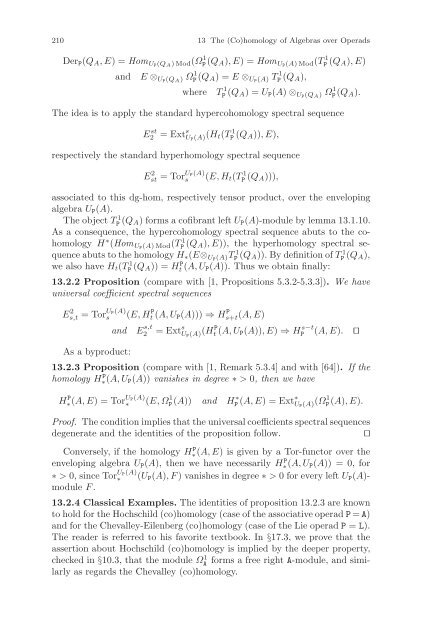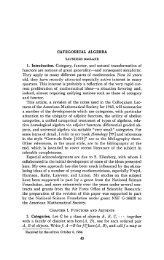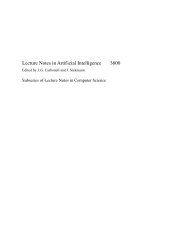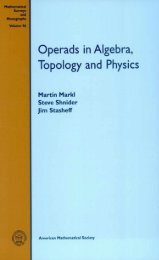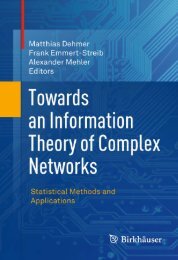Symmetric Monoidal Categories for Operads - Index of
Symmetric Monoidal Categories for Operads - Index of
Symmetric Monoidal Categories for Operads - Index of
You also want an ePaper? Increase the reach of your titles
YUMPU automatically turns print PDFs into web optimized ePapers that Google loves.
210 13 The (Co)homology <strong>of</strong> Algebras over <strong>Operads</strong><br />
DerP(QA,E)=Hom UP(QA)Mod(Ω 1 P (QA),E)=Hom UP(A)Mod(T 1 P (QA),E)<br />
and E ⊗ UP(QA) Ω 1 P (QA) =E ⊗ UP(A) T 1 P (QA),<br />
where T 1 P (QA) =UP(A) ⊗ UP(QA) Ω 1 P (QA).<br />
The idea is to apply the standard hypercohomology spectral sequence<br />
E st<br />
2 =Ext s UP(A)(Ht(T 1 P (QA)),E),<br />
respectively the standard hyperhomology spectral sequence<br />
E 2 st =TorUP(A) s (E,Ht(T 1 P (QA))),<br />
associated to this dg-hom, respectively tensor product, over the enveloping<br />
algebra UP(A).<br />
The object T 1 P (QA) <strong>for</strong>ms a c<strong>of</strong>ibrant left UP(A)-module by lemma 13.1.10.<br />
As a consequence, the hypercohomology spectral sequence abuts to the cohomology<br />
H ∗ (Hom UP(A)Mod(T 1 P (QA),E)), the hyperhomology spectral sequence<br />
abuts to the homology H∗(E⊗ UP(A)T 1 P (QA)). By definition <strong>of</strong> T 1 P (QA),<br />
we also have Ht(T 1 P (QA)) = H P t (A, UP(A)). Thus we obtain finally:<br />
13.2.2 Proposition (compare with [1, Propositions 5.3.2-5.3.3]). We have<br />
universal coefficient spectral sequences<br />
E 2 s,t =Tor UP(A)<br />
s (E,H P t (A, UP(A))) ⇒ H P s+t(A, E)<br />
and E s,t<br />
2 =Exts UP(A) (HP t (A, UP(A)),E) ⇒ H s−t<br />
P (A, E). ⊓⊔<br />
As a byproduct:<br />
13.2.3 Proposition (compare with [1, Remark 5.3.4] and with [64]). If the<br />
homology H P ∗ (A, UP(A)) vanishes in degree ∗ > 0, then we have<br />
H P ∗ (A, E) =TorUP(A) ∗ (E,Ω 1 P (A)) and H∗ P (A, E) =Ext∗UP(A) (Ω1 P (A),E).<br />
Pro<strong>of</strong>. The condition implies that the universal coefficients spectral sequences<br />
degenerate and the identities <strong>of</strong> the proposition follow. ⊓⊔<br />
Conversely, if the homology HP ∗ (A, E) is given by a Tor-functor over the<br />
enveloping algebra UP(A), then we have necessarily HP ∗(A, UP(A)) = 0, <strong>for</strong><br />
∗ > 0, since Tor UP(A)<br />
∗ (UP(A),F)vanishesindegree∗ > 0 <strong>for</strong> every left UP(A)module<br />
F .<br />
13.2.4 Classical Examples. The identities <strong>of</strong> proposition 13.2.3 are known<br />
to hold <strong>for</strong> the Hochschild (co)homology (case <strong>of</strong> the associative operad P = A)<br />
and <strong>for</strong> the Chevalley-Eilenberg (co)homology (case <strong>of</strong> the Lie operad P = L).<br />
The reader is referred to his favorite textbook. In §17.3, we prove that the<br />
assertion about Hochschild (co)homology is implied by the deeper property,<br />
checked in §10.3, that the module Ω1 A <strong>for</strong>ms a free right A-module, and similarly<br />
as regards the Chevalley (co)homology.


